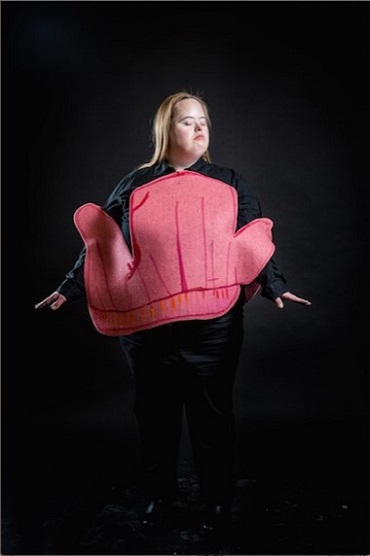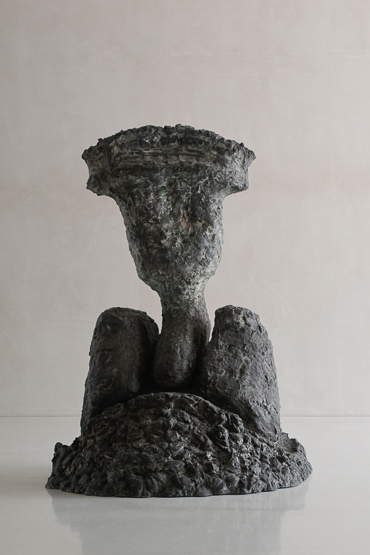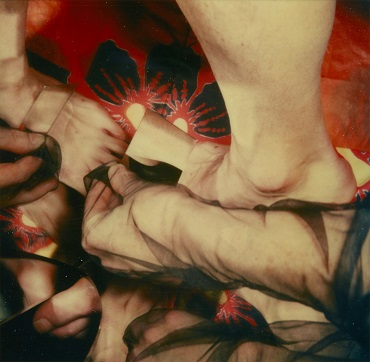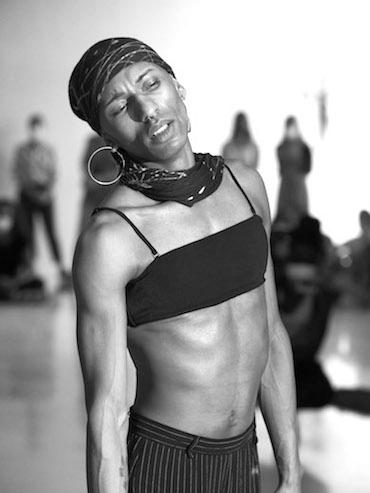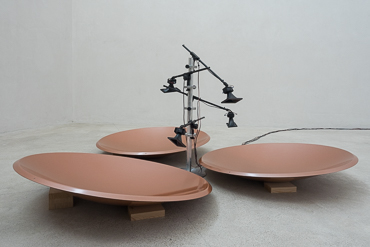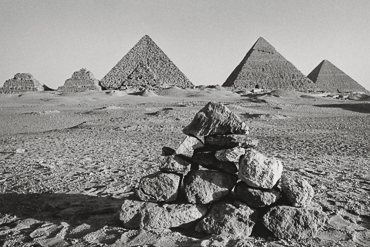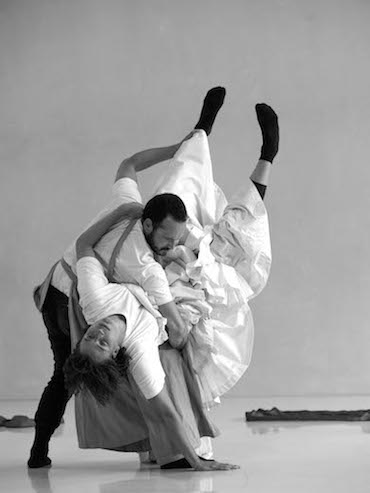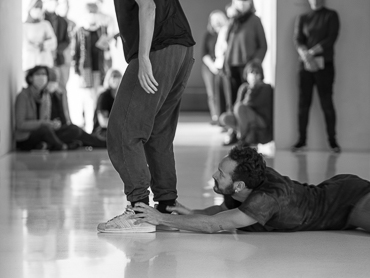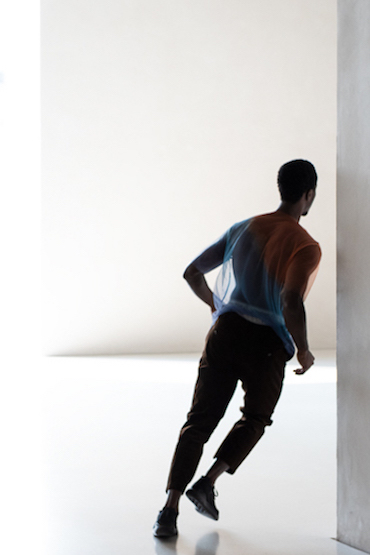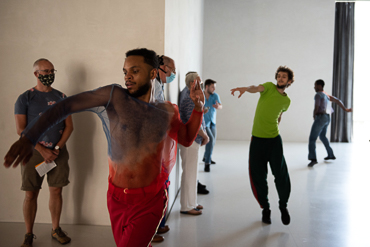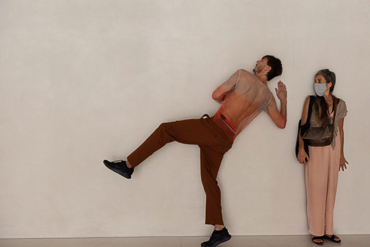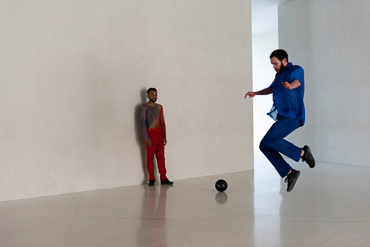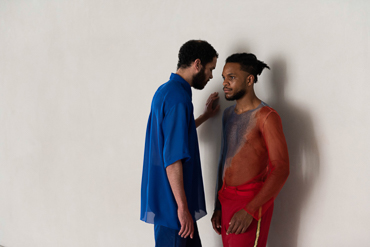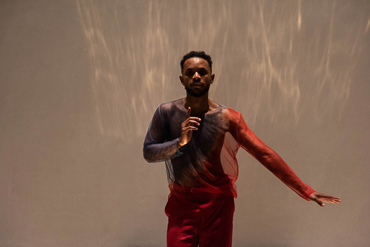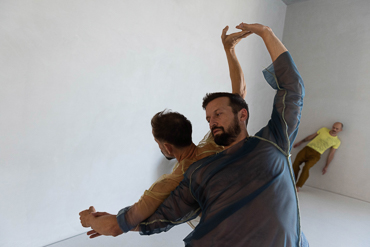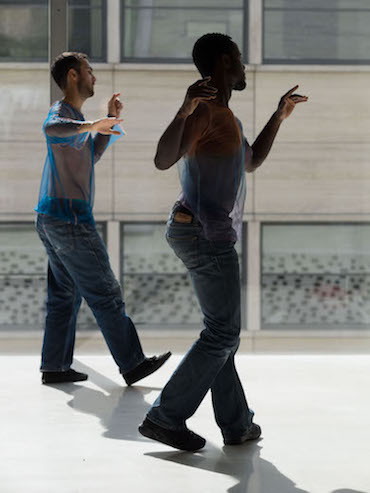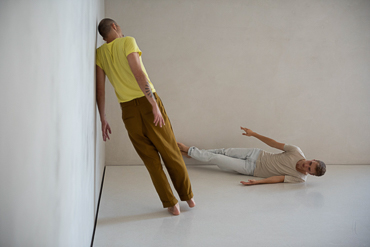14 September 2020 – 16 August 2021
»The subtle interplay between the I and the me«
Art and Choreography
A collaboration between Kolumba and tanz.Köln
Heinz Breloh, Anne Teresa De Keersmaeker/Rosas, Esther Kläs, Bernhard Leitner, Duane Michals, »Office for eyes, nose, tongue, mouth, heart, hand and mask (that covers it all)«, Richard Tuttle, Hannah Villiger
The exhibition entitled »The subtle interplay between the I and the me« unfolded in a sequence of eight chapters. The public were invited to witness this process of constant change and recombination. It brings together works by artists who subject traditional images of the body to critical revision in their search for new forms of representation. Such artists arrive at a new kind of subjectivity grounded in their own body, throwing hitherto valid concepts out of the window and initiating new criteria to apply to representation. The exhibition takes dance off the stage into the action space of the museum, in order to bring the various means of expression of the different art forms into direct contact with each other and make the overriding issues tangible: How can the body be represented? What role do corporeal experiences and memories play in how we perceive the world? Does the body think in a specific manner? Can elements of choreographic thinking be identified in fine art? What role do queer issues play here from a contemporary perspective? How does a work of art address the viewer and incorporate them into the setting? Is an exhibition a kind of choreography? What role do institutional regulations and guidelines play?
The eight chapters commence chronologically with works from the 1970s, a time when conceptual strategies and institutional critique prevailed in art, while the human body was increasingly politicized. The first phase is devoted to Heinz Breloh (we are exhibiting his work in its entirety on the occasion of his 80th birthday), Bernhard Leitner, Duane Michals, Richard Tuttle and Hannah Villiger (we have used her quote as the title of the exhibition). The exhibition spans the decades to embrace the most recent works by Esther Kläs, the Office for eyes, nose, tongue, mouth, heart, hand and mask (covering all), (Nicole Baginski, Tanja Geiß, Patrick Henkel, Eva Kot'átková, Susanne Kümpel, Andreas Maus, Michael Müller, Anna Rossa) and the Belgian choreographer and dancer Anne Teresa De Keersmaeker. De Keersmaeker and her company Rosas have created their own piece Dark Red especially for the exhibition, which we were able to present last September as an integral part of the show. More special activities will be realized in cooperation with tanz.köln up to and including the month of August, oscillating between performance and exhibition and bringing the time bound but instantaneous nature of performing arts into contact with fine arts. As so often, our own collection is both the springboard and the central focus of the project, with its monographic positions interlaced with medieval and Baroque works.
Film about the exhibition:
We publish 7 individually designed artist booklets
Please find more information about the different chapters here:
Chapter 1 - Anne Teresa De Keersmaeker/Rosas
»Dark Red« (14 – 20 September 2020, daily from 12 am to 5 pm)
The Belgian choreographer and dancer Anne Teresa De Keersmaeker (*1960) and her company Rosas created »Dark Red« especially for this location, to introduce the annual exhibition and remain an integral part of it. This work was performed for one week during regular opening times. »Dark Red« creates a space of reciprocal inspiration, taking the number 12 and the Apostolate paintings by El Greco (Toledo) as the basic theme: a dodecahedron – 12 parts of Salvatore Sciarrino’s L’Opera Per Flauto – 12 dancers. Anne Teresa De Keersmaeker’s installation in the Kabinett Room will be on show for the duration of the exhibition.
Chapter 2 - Richard Tuttle (from 24 September 2020)
The work »Ten Kinds of Memory and Memory itself« dating from 1973 will be performed every Saturday at 3 pm. This early piece by Richard Tuttle (*1941) consists of 10 drawings laid out on the floor using pieces of string. The traces of physical gestures that are incorporated into the piece open up a field of possibilities, enabling the visitors to become actors with their own agency. The notation for this piece is documented as an artist’s booklet in our series. The dancers, who take turns, are Jana Griess, Giada Peli, Jovana Petrovska, Almuth Isa Maria Schmidbauer, Katharina Senzenberger, Josefine Simonsen and Amalia Zafeiri (in collaboration with the Hochschule für Musik und Tanz Köln.
Chapter 3 - Esther Kläs (from 1 October 2020)
»We can move about. A sculpture can’t.« This observation made by Esther Kläs (*1981) might seem mundane at first, but it offers scope for the appreciation of her pieces: Esther Kläs posits the simultaneous presence of the work and the viewer. Our own response is thus determined by the impact and character of the works, whereby the optically achieved impression of structure, density and weight can at times be misleading. A publication in our series of artists’ booklets is available.
Chapter 4 - Duane Michals (from 8 October 2020)
The American artist Duane Michals (*1932) crosses the dividing lines between photography, painting and poetry. He uses photography as a medium in total contradiction to the characteristics that one usually associates with it. In his poetic series of pictures created from the mid-sixties he finds simple and striking images for existential themes such as the question of our perceptions of »reality«, social norms and values, lust, loneliness or transience and death. The series »A Promise to God« realized by Duane Michals in March 2001 on the Kolumba site is available in its entirety in our series of artists’ booklets.
Chapter 5 - Bernhard Leitner (from 15 October 2020)
As a researcher Bernhard Leitner (*1938) is the kind of artist who first needed to create his own tools, because there were no available means at his disposal at the beginning of his quest. As an architect and town planner he is a pioneer of the art form known as »sound installation«. He had already started developing novel concepts in the late sixties to create an audible space with sounds – and an associated corporeal experience. A publication in our series of artists’ booklets is available.
Chapter 6 - Hannah Villiger (from 22 October 2020)
Hannah Villiger (1951-1997) began to explore her own body with her camera in the early nineteen eighties. She used a Polaroid camera to take photographs of herself in a self-reflective dialogue – as “the subtle interplay between the I and the me” (from her diary, 1989). She enlarged the pictures thus obtained by means of an intermediate negative, and then mounted the print on thin aluminium sheet. The results were exhibited as single pictures or arranged as “blocks”. With this recourse to her own body Hannah Villiger achieved pioneering work for artists of the nineties and promoted a self-confident alternative view of the body from a female perspective. Chapter 6 has been organized in close collaboration with The Estate of Hannah Villiger and with financial support from the Swiss Arts Council Pro Helvetia and the Landis & Gyr Foundation.
Chapter 7 - »Office for eyes, nose, tongue, mouth, heart, hand and mask (covering all)« (from 29 October 2020)
In Autumn 2016 the Czech artist Eva Kot'átková spent two weeks at the Kunsthaus KAT18 in Cologne, where people with a mental handicap and artistic talent are able to work. There she noticed that the artists often work with their own body and its parts. So together they came up with the idea for an »Office for eyes, nose, tongue, mouth, hand, heart and mask (that covers it all)«, with Nicole Baginski, Tanja Geiß, Patrick Henkel, Eva Kot'átková, Susanne Kümpel, Andreas Maus, Michael Müller and Anna Rossa.
Chapter 8 - Heinz Breloh (from 5 November 2020)
In 1988 Heinz Breloh (1940–2001) developed an artistic concept of his own creative and perceptive self as a sculptor with six ends. This image was preceded by an intensive exploration over two decades of using his own body as a tool in his art practice. In the 1970s Heinz Breloh began to create works based on film and photography. These led him in the eighties to a redefinition of sculpture: he realized pieces in plaster that were made through the application of his whole body, which left a negative impression of his movements. On the occasion of his 80th birthday we are exhibiting his work for the first time in its totality, but without recourse to the conventional format of a retrospective. His most important theoretical treatise is being published in our series of artists’ booklets.
Heinz Breloh, Anne Teresa De Keersmaeker/Rosas, Esther Kläs, Bernhard Leitner, Duane Michals, »Office for eyes, nose, tongue, mouth, heart, hand and mask (that covers it all)«, Richard Tuttle, Hannah Villiger
The exhibition entitled »The subtle interplay between the I and the me« unfolded in a sequence of eight chapters. The public were invited to witness this process of constant change and recombination. It brings together works by artists who subject traditional images of the body to critical revision in their search for new forms of representation. Such artists arrive at a new kind of subjectivity grounded in their own body, throwing hitherto valid concepts out of the window and initiating new criteria to apply to representation. The exhibition takes dance off the stage into the action space of the museum, in order to bring the various means of expression of the different art forms into direct contact with each other and make the overriding issues tangible: How can the body be represented? What role do corporeal experiences and memories play in how we perceive the world? Does the body think in a specific manner? Can elements of choreographic thinking be identified in fine art? What role do queer issues play here from a contemporary perspective? How does a work of art address the viewer and incorporate them into the setting? Is an exhibition a kind of choreography? What role do institutional regulations and guidelines play?
The eight chapters commence chronologically with works from the 1970s, a time when conceptual strategies and institutional critique prevailed in art, while the human body was increasingly politicized. The first phase is devoted to Heinz Breloh (we are exhibiting his work in its entirety on the occasion of his 80th birthday), Bernhard Leitner, Duane Michals, Richard Tuttle and Hannah Villiger (we have used her quote as the title of the exhibition). The exhibition spans the decades to embrace the most recent works by Esther Kläs, the Office for eyes, nose, tongue, mouth, heart, hand and mask (covering all), (Nicole Baginski, Tanja Geiß, Patrick Henkel, Eva Kot'átková, Susanne Kümpel, Andreas Maus, Michael Müller, Anna Rossa) and the Belgian choreographer and dancer Anne Teresa De Keersmaeker. De Keersmaeker and her company Rosas have created their own piece Dark Red especially for the exhibition, which we were able to present last September as an integral part of the show. More special activities will be realized in cooperation with tanz.köln up to and including the month of August, oscillating between performance and exhibition and bringing the time bound but instantaneous nature of performing arts into contact with fine arts. As so often, our own collection is both the springboard and the central focus of the project, with its monographic positions interlaced with medieval and Baroque works.
Film about the exhibition:
We publish 7 individually designed artist booklets
Please find more information about the different chapters here:
Chapter 1 - Anne Teresa De Keersmaeker/Rosas
»Dark Red« (14 – 20 September 2020, daily from 12 am to 5 pm)
The Belgian choreographer and dancer Anne Teresa De Keersmaeker (*1960) and her company Rosas created »Dark Red« especially for this location, to introduce the annual exhibition and remain an integral part of it. This work was performed for one week during regular opening times. »Dark Red« creates a space of reciprocal inspiration, taking the number 12 and the Apostolate paintings by El Greco (Toledo) as the basic theme: a dodecahedron – 12 parts of Salvatore Sciarrino’s L’Opera Per Flauto – 12 dancers. Anne Teresa De Keersmaeker’s installation in the Kabinett Room will be on show for the duration of the exhibition.
Chapter 2 - Richard Tuttle (from 24 September 2020)
The work »Ten Kinds of Memory and Memory itself« dating from 1973 will be performed every Saturday at 3 pm. This early piece by Richard Tuttle (*1941) consists of 10 drawings laid out on the floor using pieces of string. The traces of physical gestures that are incorporated into the piece open up a field of possibilities, enabling the visitors to become actors with their own agency. The notation for this piece is documented as an artist’s booklet in our series. The dancers, who take turns, are Jana Griess, Giada Peli, Jovana Petrovska, Almuth Isa Maria Schmidbauer, Katharina Senzenberger, Josefine Simonsen and Amalia Zafeiri (in collaboration with the Hochschule für Musik und Tanz Köln.
Chapter 3 - Esther Kläs (from 1 October 2020)
»We can move about. A sculpture can’t.« This observation made by Esther Kläs (*1981) might seem mundane at first, but it offers scope for the appreciation of her pieces: Esther Kläs posits the simultaneous presence of the work and the viewer. Our own response is thus determined by the impact and character of the works, whereby the optically achieved impression of structure, density and weight can at times be misleading. A publication in our series of artists’ booklets is available.
Chapter 4 - Duane Michals (from 8 October 2020)
The American artist Duane Michals (*1932) crosses the dividing lines between photography, painting and poetry. He uses photography as a medium in total contradiction to the characteristics that one usually associates with it. In his poetic series of pictures created from the mid-sixties he finds simple and striking images for existential themes such as the question of our perceptions of »reality«, social norms and values, lust, loneliness or transience and death. The series »A Promise to God« realized by Duane Michals in March 2001 on the Kolumba site is available in its entirety in our series of artists’ booklets.
Chapter 5 - Bernhard Leitner (from 15 October 2020)
As a researcher Bernhard Leitner (*1938) is the kind of artist who first needed to create his own tools, because there were no available means at his disposal at the beginning of his quest. As an architect and town planner he is a pioneer of the art form known as »sound installation«. He had already started developing novel concepts in the late sixties to create an audible space with sounds – and an associated corporeal experience. A publication in our series of artists’ booklets is available.
Chapter 6 - Hannah Villiger (from 22 October 2020)
Hannah Villiger (1951-1997) began to explore her own body with her camera in the early nineteen eighties. She used a Polaroid camera to take photographs of herself in a self-reflective dialogue – as “the subtle interplay between the I and the me” (from her diary, 1989). She enlarged the pictures thus obtained by means of an intermediate negative, and then mounted the print on thin aluminium sheet. The results were exhibited as single pictures or arranged as “blocks”. With this recourse to her own body Hannah Villiger achieved pioneering work for artists of the nineties and promoted a self-confident alternative view of the body from a female perspective. Chapter 6 has been organized in close collaboration with The Estate of Hannah Villiger and with financial support from the Swiss Arts Council Pro Helvetia and the Landis & Gyr Foundation.
Chapter 7 - »Office for eyes, nose, tongue, mouth, heart, hand and mask (covering all)« (from 29 October 2020)
In Autumn 2016 the Czech artist Eva Kot'átková spent two weeks at the Kunsthaus KAT18 in Cologne, where people with a mental handicap and artistic talent are able to work. There she noticed that the artists often work with their own body and its parts. So together they came up with the idea for an »Office for eyes, nose, tongue, mouth, hand, heart and mask (that covers it all)«, with Nicole Baginski, Tanja Geiß, Patrick Henkel, Eva Kot'átková, Susanne Kümpel, Andreas Maus, Michael Müller and Anna Rossa.
Chapter 8 - Heinz Breloh (from 5 November 2020)
In 1988 Heinz Breloh (1940–2001) developed an artistic concept of his own creative and perceptive self as a sculptor with six ends. This image was preceded by an intensive exploration over two decades of using his own body as a tool in his art practice. In the 1970s Heinz Breloh began to create works based on film and photography. These led him in the eighties to a redefinition of sculpture: he realized pieces in plaster that were made through the application of his whole body, which left a negative impression of his movements. On the occasion of his 80th birthday we are exhibiting his work for the first time in its totality, but without recourse to the conventional format of a retrospective. His most important theoretical treatise is being published in our series of artists’ booklets.
